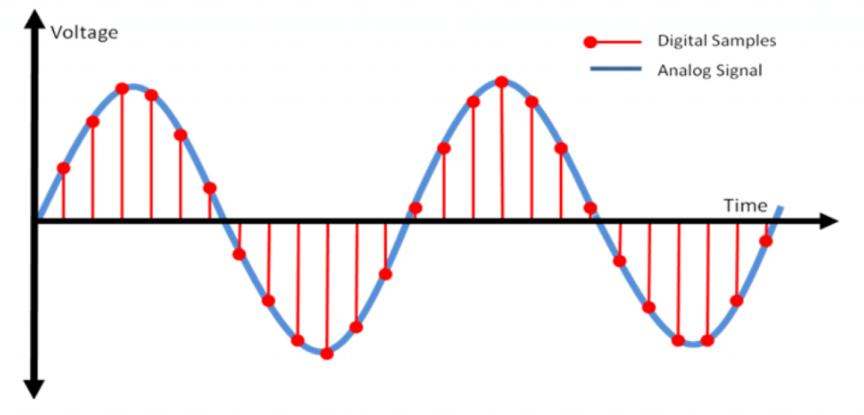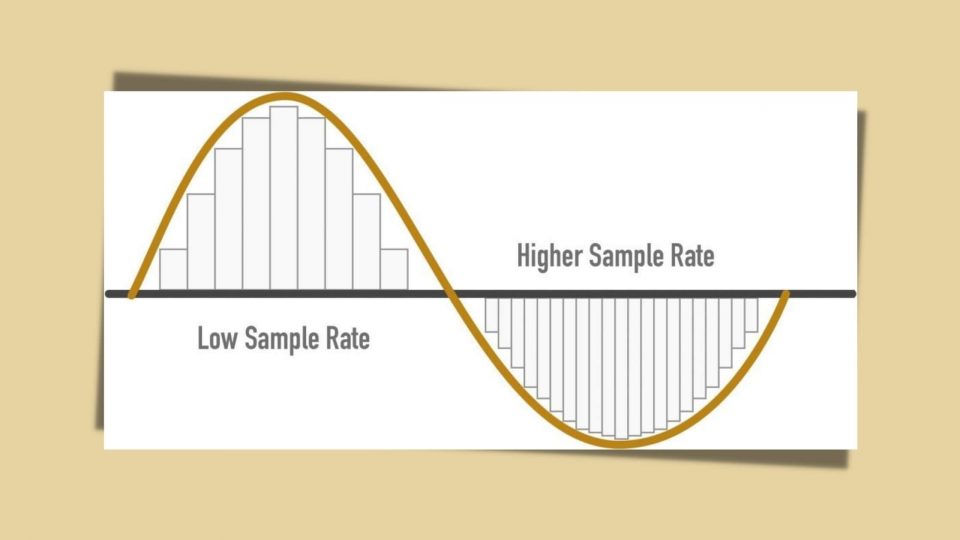What is an Audio Sample Rate?
What is Digital Audio?
You’ve been recording your vocals and you’re impressed with your killer voice. You give yourself a nod in the mirror that says “good job”.
However, you find yourself curious about what’s actually happening inside your gear when you record your audio.
Characteristics like the frequency and amplitude of your acoustic sound waves have been converted into binary data that your computer can read. This converted sound wave is what we call digital audio, and this now allows you to edit and manipulate your vocals inside your DAW.
What is an Audio Sample?
Before your computer receives binary 1s & 0s that it can read, the soundwave of your vocals has been converted into that data through a series of snapshot measurements called samples.
To reproduce the beauty of your killer voice, thousands of samples need to be mapped out per second. The amplitudes that your vocal soundwave is reaching is measured, and the samples are measured at particular times too!
If we measure samples extremely quickly and measure enough amplitude values, we can reconstruct the resolution of your acoustic vocals!

For the best visual representation of this conversion, our hats are off to iZotope.
What is Sample Rate in Audio?
The short answer is the speed of measurement and the number of sample measurements made, which is measured in kilohertz.
You can see in the image above that the more measurements that are made give a better representation of the original soundwave.
Let’s break a soundwave down some more. A soundwave is made up of cycles, and one cycle has one positive and one negative amplitude stage. To discover the wavelength, which would be the length of the individual cycle, we need to measure both the positive and negative amplitudes. Both the positive and negative amplitudes must be sampled at least once, so each cycle is consequently sampled twice.
Therefore, the sample rate determines the range of frequencies measured in digital audio form.
By sampling a soundwave at least two times per cycle we work out the frequency of the overall waveform itself.
This means that we can reconstruct a soundwave in digital form with a sample rate that’s twice the frequency of the original soundwave (because we are sampling every cycle twice)!
This is known as the Nyquist rate. A system can reconstruct frequencies up to half of the sample rate used, and this halfway line is known as the Nyquist frequency!
What is the Sample Rate of CD Audio?
The standard sample rate for CDs and music streaming services is 44.1kHz, which translates to 44,100 samples measured per second. This is the most common sample rate that you have probably seen.
What Audio Sample Rate Should I Use? What is Aliasing?
We puny humans are limited to only hearing frequencies between 20Hz & 20kHz, so a sample rate of 44.1kHz makes sense, right? If we want to accurately reconstruct audio that’s 20kHz, a sample rate that’s taking measurements twice every cycle will naturally give us a sample rate of 40kHz.
But what’re the extra 100 samples for?
If you’re not familiar with aliasing, it’s when soundwaves become unrecognisable from one another. It’s an error that arises in sampling audio – the sampled waves become aliases of one another! Any signals above the Nyquist frequency don’t get sampled properly by audio-to-digital converters and get mirrored back across the Nyquist frequency, which causes aliasing.
Therefore, we have our Nyquist frequency outside of the threshold of human hearing (at 20.05kHz) so that aliasing is less obvious to our ears. By having our Nyquist frequency outside of our hearing range, we can easily hide aliasing with low pass filters before audio reaches the analog to digital converter!

What Audio Sample Rate Should I Use?
44.1kHz is the most common and accepted sample rate for consumer audio like CD’s & music streaming.
However, you’ve probably noticed that your DAW has sample rate options. That’s because there are actually instances where a higher sample rate is used.
48 kHz is another very common sample rate. This is because this higher sample rate does lead to more per second measurements of the audio, which leads to a closer reproduction of the original audio source. 48 kHz is often used in other professional audio circumstances, rather than music production scenarios, like in audio for film.
48kHz moves the Nyquist frequency all the way to 24 kHz and allows for further buffer room before any filter filtering is needed.
Sample rates tend to be in multiples of 44.1kHz. Some engineers choose to work with rates of 88.2kHz, 96 kHz, 176.4 kHz, and 192 kHz.
These higher sample rates are used because low pass filters have less impact on the sound and offer more samples per second, which obviously brings a more accurate recreation of the original audio.
Why is 44.1kHz the Standard For Consumer Audio?
Of course, it’s great to work with a higher audio sample rate. Maximising the reproduction quality of the original audio is something we can all get behind, surely?
However, the files will be much larger. In the end, however, the audio will likely be converted to 44.1 kHz for streaming services as this was the standard for CDs too.
Mathematically, it’s a lot easier to convert 88.2 to 44.1 and 96 to 48 (which is why these are the two most common rates). This is why, for the entire project, it’s better to stay in one format.
If your audio playback system was set with a sample rate of 48 kHz, but you were listening to an audio file with a rate of 44.1 kHz, the audio would be read faster than it should.
This would speed up the audio and make it sound higher pitched. If the systems sample rate was 44.1 kHz and the audio file was at 48 kHz, the audio would sound lower-pitched and slowed down.
These may sound like unwanted consequences, but there are creative uses here. Audio samples with very high rates can also have interesting creative use.
Go & lower the pitch of a 44.1 kHz audio file. Notice how empty they sound in the highs? That’s because frequencies above the 22.05 kHz threshold were filtered out pre-conversion. That means there is no audio to pitch down in the highs, which has given you a quiet hole there.
This means that if you were to use the highest sample rate of 192kHz, the Nyquist frequency would be 96kHz. Above the threshold of human hearing (by a lot), but if you were to pitch this high sample rate audio file down… there would be lots of frequency content left to hear in the highs.
Basically, sample rates can be a fantastic tool to play with if you were to dabble in resampling/sample based synthesis.
Of course, if you’d rather download some vocal samples than record your own… Mixxed has a plethora of sounds for you to choose from to accentuate your music from the rest!
